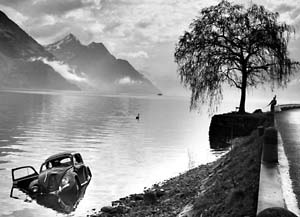A minibus lies overturned, papers spilling in its wake. Battered vehicles commiserate at a deserted intersection. A Volkswagen Beetle sinks slowly into an otherwise pristine Alpine lake.

These haunting images are the work of Arnold Odermatt, a retired Swiss policeman whose photographs of accident scenes, though possessed of almost surreal beauty and clarity, have only recently come to the attention of the international art world.
This spring, the Gallery of Art will present a rare U.S. exhibition of more than 30 black-and-white and color images by the nowseptuagenarian wunderkind.
Contemporary Projects: Arnold Odermatt Photographs will open with a reception from 5:30-7:30 p.m. March 11 and will remain on view through April 20.
Born in 1925 in the small Swiss town of Oberdorf, Odermatt originally trained as a baker and confectioner. In 1948, he joined the police force in Nidwalden, a remote, largely agrarian canton containing 11 small communities and, even today, fewer than 40,000 citizens.
At the time, “accidents constituted the main occupation of police work,” said Sabine Eckmann, Ph.D., curator of the Gallery of Art. “About 600 cars crowded the underdeveloped roads, with an average of one car accident daily and about 10 fatalities per year.”
Odermatt was the first officer in Switzerland to begin documenting these tragic scenes on film, and he created two distinct bodies of work. Setting his tripod on the roof of a police van, he first shot a series of straightforward images to accompany accident reports and on-site police drawings.
Hours later, when onlookers had gone and most traces of violence had been cleared away, he returned to make a final, more highly aestheticized portrait of the wrecked vehicles.
Devoid of blood or victims, presented in crisp black-and-white, these latter images stand in marked contrast both to earlier “crime photography” — Weegee’s crowded tenement scenes of the 1930s and ’40s, for example — and to works by contemporary artists such as Andy Warhol, whose acidly colored “car crash” paintings mimicked the garish sensationalism of tabloid scandal sheets.
Odermatt, by emphasizing the “object character of the car,” uniquely engaged “problems of a belated modernization caused by the invasion of the automobile into an agrarian area,” Eckmann said.
Yet, “Rather than letting the shocks of modernity fragment his senses, Odermatt creates images of empathy and sensuality that seek to control yet, importantly, also admit the progress of modernization as it penetrated his locality.”
Odermatt’s color photos, begun later in his career, focus on the activities of local police — shooting exercises, parades and festivals, on the beach practicing CPR.
“These photographs often served the function of promoting police work rather than documenting life in rural Switzerland,” Eckmann said. “Yet while they are obviously staged, they don’t come across as formal or official.
“Caught in their time through design, fashion and equipment, they convey the particulars and arbitrariness of the everyday, its structures and its practices.”
Odermatt retired in 1990, having reached the rank of deputy commander. In 1993, however, his work was “discovered” by independent curator Beate Kemfert, and a series of exhibitions in Switzerland and Germany soon followed.
Most recently, Odermatt was featured in the 2001 Venice Biennial international exhibition and in a solo exhibition at the Art Institute of Chicago.
At 7 p.m. March 14, Eckmann and Kemfert will lead a discussion of Odermatt’s work for the Gallery of Art’s Friday Forum discussion series. Cost is $10, including wine and appetizers. Reservations are required. For more information, call 935-5490 or email wuga@aismail.wustl.edu.
Support for Arnold Odermatt is provided by the PRO HELVETIA Arts Council of Switzerland, the St. Louis Print-market and individual contributors.
The Gallery of Art exhibit is free and open to the public.
Gallery hours are 10 a.m.-4:30 p.m. Tuesday through Thursday; 10 a.m.-8 p.m. Fridays; and noon-4:30 p.m. weekends. (The gallery is closed Mondays.)
For more information, call 935-4523.